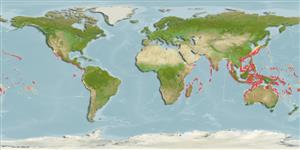Actinopterygii (ray-finned fishes) >
Perciformes (Perch-likes) >
Lethrinidae (Emperors or scavengers) > Monotaxinae
Environment / Climate / Range
Ecology
Marine; reef-associated; non-migratory; depth range 100 - 200 m (Ref. 86942). Deep-water, preferred ?; 35°N - 34°S
Indo-West Pacific: tropical, known only from a few scattered localities.
Length at first maturity / Size / Weight / Age
Maturity: Lm 31.0 range ? - ? cm
Max length : 55.0 cm TL male/unsexed; (Ref. 2295); common length : 35.0 cm TL male/unsexed; (Ref. 2295)
Dorsal
spines
(total): 10;
Dorsal
soft rays
(total): 10;
Anal
spines: 3;
Anal
soft rays: 10. The inner surface of the pectoral fin axil without scales. Overall color is silvery-gray with yellowish suffusion; scale margins are narrowly brownish. Indistinct dark blotches or bars are sometimes apparent on the body. The lips are whitish to yellow. The fins are yellow, faint brown spotting may be present on soft dorsal, anal, and caudal fins. A narrow blackish bar runs across the base of the pectoral fin.
Inhabits the outer edge of the continental shelf. Feeds on bottom-living invertebrates and small fishes. Caught mainly with bottom longlines and bottom trawls (Ref. 9775).
Life cycle and mating behavior
Maturity | Reproduction | Spawning | Eggs | Fecundity | Larvae
Carpenter, K.E. and G.R. Allen, 1989. FAO Species Catalogue. Vol. 9. Emperor fishes and large-eye breams of the world (family Lethrinidae). An annotated and illustrated catalogue of lethrinid species known to date. FAO Fish. Synop. 125(9):118 p. Rome: FAO. (Ref. 2295)
IUCN Red List Status (Ref. 115185)
CITES (Ref. 94142)
Not Evaluated
Threat to humans
Harmless
Human uses
Fisheries: minor commercial
More information
ReferencesAquacultureAquaculture profileStrainsGeneticsAllele frequenciesHeritabilityDiseasesProcessingMass conversion
Tools
Special reports
Download XML
Internet sources
